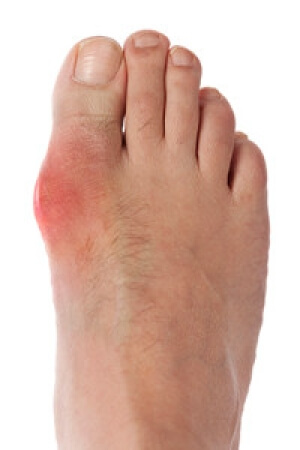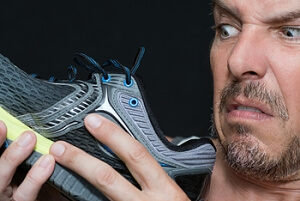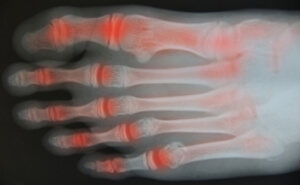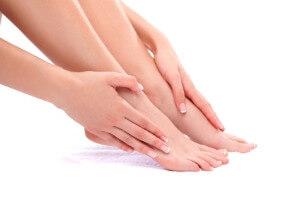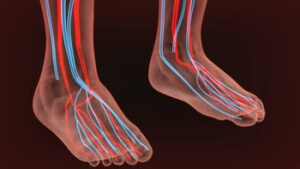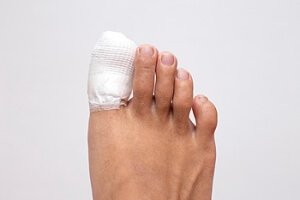Super User
Gout May Cause Severe Pain
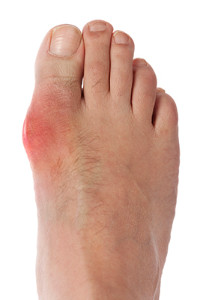 If you have ever been afflicted with gout, you are most likely aware of the pain and discomfort this condition may cause. Research has shown that having a genetic predisposition may aid in the occurrence of primary gout, and secondary gout may occur as a result of ingesting diuretics on a long-term basis. This painful ailment will typically affect the joints of the big toe and is the result of crystals that form in the blood, which lodge in the joints. Ingesting foods that are high in purine levels may aid in the formation of these crystals, and it is advised to avoid or limit eating these types of foods, which may include shellfish, red meat, or excessive alcohol. Keeping your weight at a healthy level and drinking plenty of fresh water daily may be effective ways in helping to prevent painful gout attacks. If you feel you have gout, it is advised to speak with a podiatrist as quickly as possible, so the proper treatment techniques can begin, and relief can be attained.
If you have ever been afflicted with gout, you are most likely aware of the pain and discomfort this condition may cause. Research has shown that having a genetic predisposition may aid in the occurrence of primary gout, and secondary gout may occur as a result of ingesting diuretics on a long-term basis. This painful ailment will typically affect the joints of the big toe and is the result of crystals that form in the blood, which lodge in the joints. Ingesting foods that are high in purine levels may aid in the formation of these crystals, and it is advised to avoid or limit eating these types of foods, which may include shellfish, red meat, or excessive alcohol. Keeping your weight at a healthy level and drinking plenty of fresh water daily may be effective ways in helping to prevent painful gout attacks. If you feel you have gout, it is advised to speak with a podiatrist as quickly as possible, so the proper treatment techniques can begin, and relief can be attained.
Gout is a foot condition that requires certain treatment and care. If you are seeking treatment, contact one of our podiatrists from New Tampa Foot & Ankle. Our doctors will treat your foot and ankle needs.
What Is Gout?
Gout is a type of arthritis caused by a buildup of uric acid in the bloodstream. It often develops in the foot, especially the big toe area, although it can manifest in other parts of the body as well. Gout can make walking and standing very painful and is especially common in diabetics and the obese.
People typically get gout because of a poor diet. Genetic predisposition is also a factor. The children of parents who have had gout frequently have a chance of developing it themselves.
Gout can easily be identified by redness and inflammation of the big toe and the surrounding areas of the foot. Other symptoms include extreme fatigue, joint pain, and running high fevers. Sometimes corticosteroid drugs can be prescribed to treat gout, but the best way to combat this disease is to get more exercise and eat a better diet.
If you have any questions please feel free to contact our office located in Wesley Chapel, FL . We offer the newest diagnostic and treatment technologies for all your foot and ankle needs.
How to Control Plantar Hyperhidrosis
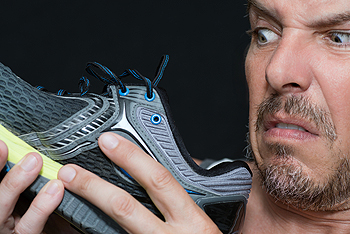 If sporting activities are practiced on a frequent basis, it may be common to experience sweaty feet. The medical condition that is referred to as plantar hyperhidrosis occurs when feet sweat excessively everyday, and will typically be uncomfortable. Additionally, it may lead to the development of other conditions, which may include athlete's foot, toenail fungus, or offensive foot odor. This excessive sweating may be a result of extreme quantities of sweat that comes from sweat glands that may not be functioning properly. There may be several ways to prevent and control this embarrassing condition, including choosing to wear cotton socks, which may absorb sweat, applying an appropriate antiperspirant to the feet, drinking plenty of fresh water on a daily basis, in addition to wearing shoes that are made of breathable materials. If you are afflicted with plantar hyperhidrosis, it’s advised to consult with a podiatrist who can offer the best treatment options for you.
If sporting activities are practiced on a frequent basis, it may be common to experience sweaty feet. The medical condition that is referred to as plantar hyperhidrosis occurs when feet sweat excessively everyday, and will typically be uncomfortable. Additionally, it may lead to the development of other conditions, which may include athlete's foot, toenail fungus, or offensive foot odor. This excessive sweating may be a result of extreme quantities of sweat that comes from sweat glands that may not be functioning properly. There may be several ways to prevent and control this embarrassing condition, including choosing to wear cotton socks, which may absorb sweat, applying an appropriate antiperspirant to the feet, drinking plenty of fresh water on a daily basis, in addition to wearing shoes that are made of breathable materials. If you are afflicted with plantar hyperhidrosis, it’s advised to consult with a podiatrist who can offer the best treatment options for you.
If you are suffering from hyperhidrosis contact one of our podiatrists of New Tampa Foot & Ankle. Our doctors can provide the care you need to attend to all of your foot and ankle needs.
Hyperhidrosis of the Feet
Hyperhidrosis is a rare disorder that can cause people to have excessive sweating of their feet. This can usually occur all on its own without rigorous activity involved. People who suffer from hyperhidrosis may also experience sweaty palms.
Although it is said that sweating is a healthy process meant to cool down the body temperature and to maintain a proper internal temperature, hyperhidrosis may prove to be a huge hindrance on a person’s everyday life.
Plantar hyperhidrosis is considered to be the main form of hyperhidrosis. Secondary hyperhidrosis can refer to sweating that occurs in areas other than the feet or hands and armpits. Often this may be a sign of it being related to another medical condition such as menopause, hyperthyroidism and even Parkinson’s disease.
In order to alleviate this condition, it is important to see your doctor so that they may prescribe the necessary medications so that you can begin to live a normal life again. If this is left untreated, it is said that it will persist throughout an individual’s life.
A last resort approach would be surgery, but it is best to speak with your doctor to find out what may be the best treatment for you.
If you have any questions please feel free to contact our office located in Wesley Chapel, FL . We offer the newest diagnostic and treatment technologies for all your foot and ankle needs.
Hyperhidrosis of the Feet
Each foot, on average, has about 250,000 eccrine sweat glands that produce half a pint of sweat each day. Sweating is a natural and important bodily function. It regulates the body’s temperature by cooling the skin so that it does not overheat. In individuals with hyperhidrosis, the sympathetic nervous system works in "overdrive", producing far more sweat than what is required. People with plantar hyperhidrosis experience an excess amount of sweat on their feet. It is estimated that 2% to 3% of all Americans suffer from some form of hyperhidrosis. This condition is often caused by neurologic, endocrine, infectious, and other systemic disease. Other factors that may trigger the condition are heat and emotions.
People with hyperhidrosis may notice an overabundance of sweat on their feet, along with a strong odor. The feet may also have a wet appearance coupled with infections such as athlete’s foot or toenail fungus. The sweat may even appear in low temperatures, such as during the winter months. People with plantar hyperhidrosis often need to change their socks several times throughout the day.
The specific cause of hyperhidrosis is unknown, and many believe it may be caused by over-activity. However, others believe the condition is genetic. Caffeine and nicotine are known to cause excitement and nervousness which are two emotions that may make the condition worse.
If you are looking to treat your hyperhidrosis the most important thing you should do is wash your feet every day. You may even need to wash your feet twice a day, if necessary. You should also make sure you are wearing the right socks. Wool and cotton socks are both known to be good for ventilation, meaning they allow the feet to breathe. You should avoid socks made from nylon which trap moisture and lead to sogginess. Other common treatment options are over-the-counter antiperspirants that contain a low dose of metal salt. In some cases, prescription strength antiperspirants that contain aluminum chloride hexahydrate may be necessary. In severe cases, surgery may be required.
Untreated hyperhidrosis can easily lead to complications. Some complications that may arise from the disorder include nail infections, warts, and bacterial infections. Consequently, it is important that you seek treatment from your podiatrist if you suspect that you may have plantar hyperhidrosis.
Rheumatoid Arthritis May Affect Different Parts of the Foot
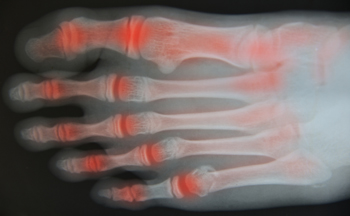 If you are experiencing chronic pain, which may be caused by inflammation in your feet, you may have rheumatoid arthritis. This uncomfortable ailment is caused by an autoimmune condition and will typically affect the tissues in the feet, which may cause severe pain and swelling. When this condition develops in the feet, the joints in the ankle may become affected as a result of possible damage that the tissues and ligaments may endure. This may cause diminished support in the ankle bones and can cause difficulty in walking. If rheumatoid arthritis (RA) develops in the center of the foot, damage to the ligaments may cause the arch to gradually collapse, and desired relief may be felt by wearing shoe inserts. If you are experiencing this type of foot pain, it’s suggested to consult with a podiatrist, so the proper treatment techniques can begin.
If you are experiencing chronic pain, which may be caused by inflammation in your feet, you may have rheumatoid arthritis. This uncomfortable ailment is caused by an autoimmune condition and will typically affect the tissues in the feet, which may cause severe pain and swelling. When this condition develops in the feet, the joints in the ankle may become affected as a result of possible damage that the tissues and ligaments may endure. This may cause diminished support in the ankle bones and can cause difficulty in walking. If rheumatoid arthritis (RA) develops in the center of the foot, damage to the ligaments may cause the arch to gradually collapse, and desired relief may be felt by wearing shoe inserts. If you are experiencing this type of foot pain, it’s suggested to consult with a podiatrist, so the proper treatment techniques can begin.
Because RA affects more than just your joints, including the joints in your feet and ankles, it is important to seek early diagnosis from your podiatrist if you feel like the pain in your feet might be caused by RA. For more information, contact one of our podiatrists of New Tampa Foot & Ankle. Our doctors will assist you with all of your podiatric concerns.
What Is Rheumatoid Arthritis?
Rheumatoid Arthritis (RA) is an autoimmune disorder in which the body’s own immune system attacks the membranes surrounding the joints. Inflammation of the lining and eventually the destruction of the joint’s cartilage and bone occur, causing severe pain and immobility.
Rheumatoid Arthritis of the Feet
Although RA usually attacks multiple bones and joints throughout the entire body, almost 90 percent of cases result in pain in the foot or ankle area.
Symptoms
- Swelling and pain in the feet
- Stiffness in the feet
- Pain on the ball or sole of feet
- Joint shift and deformation
Diagnosis
Quick diagnosis of RA in the feet is important so that the podiatrist can treat the area effectively. Your doctor will ask you about your medical history, occupation, and lifestyle to determine the origin of the condition. Rheumatoid Factor tests help to determine if someone is affected by the disease.
If you have any questions please feel free to contact our office located in Wesley Chapel, FL . We offer the newest diagnostic and treatment technologies for all your foot and ankle needs.
Rheumatoid Arthritis in the Feet
Although rheumatoid arthritis attacks multiple bones and joints throughout the entire body, ninety percent of people who actually develop this condition usually do so in the foot or ankle area. Those who develop this kind of arthritis in the feet usually develop symptoms around the toes and forefeet first, before anywhere else. Rheumatoid arthritis appears to have a genetic component. If it runs in the family, then you will be more likely to develop it as well.
Rheumatoid arthritis is an autoimmune disorder in which the body’s own immune system attacks the lining of the membranes surrounding the joints. This causes inflammation of the membrane lining, and the gradual destruction of the joint’s cartilage and even bone.
Some of the most common symptoms that are associated with RA include pain and swelling of the feet. Stiffness in the feet is also another common symptom that people experience. Those who have RA in the feet usually feel the pain in the ball or sole of their feet. This can get to be very painful at times. A person's joints can even shift and become deformed after a period of time.
In order to properly diagnose RA in the feet it is usually necessary for a doctor or podiatrist to evaluate the area. Your doctor will also question you about your medical history, occupation, etc., to determine whether anything in your lifestyle may have triggered the condition. There are a number of tests that may be performed to help diagnose RA, such as a rheumatoid factor test. There is, however, no one single test that will tell you for sure if you have RA. There are different X-rays that can be taken as well to determine if a person has RA in their feet.
There is a range of treatment options for rheumatoid arthritis. Treatment of RA is usually a lifelong process that includes a variety of methods of treatment and therapy. Your doctor can prescribe special shoes that should help with arch support as well as heel support. A physical therapist can help those with this condition learn exercises which will keep their joints flexible. Surgery may be needed to correct some of the issues with the feet, such as bunions, and hammertoes. Fusion is usually the most successful surgical option for rheumatoid arthritis. However, people need to keep in mind that there are some risks associated with these surgeries.
Tracing Your Foot May Aid in Determining the Correct Shoe Size
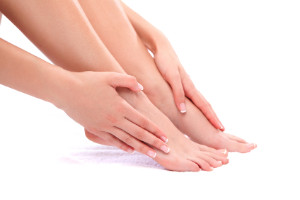 Most people have feet that are two different sizes. It’s important to use proper techniques for determining the correct shoe size, and this may aid in preventing uncomfortable foot conditions from developing. This often includes ensuring there is adequate room for the toes to move about freely in, and the feet will benefit by wearing shoes that bend at the ball of the foot. Research has shown the best time of day to purchase shoes is at the end of the day when the feet may be the largest. An accurate shoe measurement can be obtained by tracing your foot on a piece of paper, while wearing socks that you would most likely wear daily. When the foot is traced with a pencil that is held in an upright position, the measurement may be more accurate than if the pencil is angled as this process occurs. After completing this, the shoe size to be determined is by the foot that is the largest and longest. If you would like additional information about how to properly measure your feet so the correct size shoes can be worn, it’s suggested to speak with a podiatrist.
Most people have feet that are two different sizes. It’s important to use proper techniques for determining the correct shoe size, and this may aid in preventing uncomfortable foot conditions from developing. This often includes ensuring there is adequate room for the toes to move about freely in, and the feet will benefit by wearing shoes that bend at the ball of the foot. Research has shown the best time of day to purchase shoes is at the end of the day when the feet may be the largest. An accurate shoe measurement can be obtained by tracing your foot on a piece of paper, while wearing socks that you would most likely wear daily. When the foot is traced with a pencil that is held in an upright position, the measurement may be more accurate than if the pencil is angled as this process occurs. After completing this, the shoe size to be determined is by the foot that is the largest and longest. If you would like additional information about how to properly measure your feet so the correct size shoes can be worn, it’s suggested to speak with a podiatrist.
Finding a properly-fitting shoe is important in reducing injuries and preventing foot problems. For more information about treatment, contact one of our podiatrists from New Tampa Foot & Ankle. Our doctors will treat your foot and ankle needs.
Proper Shoe Fitting
A common concern when it comes to foot health, having properly fitted shoes can help prevent injuries to the foot. Out feet affect our posture and gait, which in turn affects the biomechanics and overall bodily structure. With 33 joints, 26 bones, and over 100 ligaments, the potential for serious injury is much greater than one realizes. Although the feet cease growth in adulthood, they still change shape as they mature. Here are some factors to consider when it comes to investing in proper fitting shoes:
- Be sure the shoes fit correctly right away
- Ensure the ball of your foot fits comfortably in the widest portion of the shoes
- Even though they may look fashionable, improper fitting shoes can either create adverse conditions or exacerbate existing ones you may already have
- Walk along a carpeted surface to ensure the shoes comfortably fit during normal activity
Keeping in mind how shoes fit the biomechanics of your body, properly-fitting shoes are vitally important. Fortunately, it is not difficult to acquire footwear that fits correctly. Be sure to wear shoes that support the overall structure of your body. Do your feet a favor and invest in several pairs of well-fitted shoes today.
If you have any questions please feel free to contact our office located in Wesley Chapel, FL . We offer the newest diagnostic and treatment technologies for all your foot and ankle needs.
Proper Shoe Fitting
When it comes to maintaining foot health, wearing properly-fitting shoes is important. While wearing the appropriate pair of shoes may seem like a trivial concern, the reality is that improperly fitted shoes cause an astounding amount of injuries to the feet. The overall structure and the biomechanics of our bodies are directly affected by our posture, gait, and feet. Because of this, pain and discomfort felt throughout the body are often related to a problem in the feet. And, most foot problems usually stem from improper footwear.
Shoes should not be purchased with the expectation that they will easily stretch and contort to the size and shape of your feet. When shopping for footwear, look for shoes that fit correctly and comfortably as soon as you put them on. Do not purchase shoes that are too large or that slip in the heel area when you walk. Do not choose shoes that are loose with the intention of wearing thicker socks to compensate for the space. The widest portion of the shoe, the ball of the foot, must be made sure to fit comfortably in the shoe.
Keeping all of these suggestions in mind may be difficult when shopping and when trying to select from a wide array of different shoes. Nonetheless, your time and money will be wasted if you purchase a pair of shoes that are too uncomfortable for you to actually wear them. After finally selecting and purchasing a pair of shoes, try them on at home. To truly ensure whether or not your shoes fit comfortably with normal activity, walk around on a carpeted surface to determine how they feel on your feet.
The possibility of damaging your feet’s 33 joints, 26 bones, and 100+ ligaments is much higher than many people suspect. Finding an appropriate and properly-fitted pair of shoes is perhaps the single most important action you can take to maintain excellent foot health and help prevent injury. The fact that our feet continue to change with age is one that many people often forget. Even if our feet no longer change in size when we mature, our feet will still change in shape.
If you already have pre-existing foot problems, there is a greater possibility that wearing improperly-fitted shoes will worsen those problems. The good news, however, is that appropriate footwear is not difficult to find. While shopping for shoes, remember that improper footwear can detrimentally affect the feet, the entire body and its biomechanical structure as well. The shoes you wear can greatly impact your legs, back, and entire body, as your posture and gait are related to your feet. Finding and selecting the best properly-fitted shoes is necessary in achieving optimal health.
Foot Conditions That Are Associated With Running
 Many people who enjoy running may experience common foot conditions that may be associated with this sport. A portion of the foot that is commonly affected is the the plantar fascia. This is identified as the tissue that is located on the bottom of the foot and connects the heel bone to the toes. If this should become torn or injured, it will most likely produce severe pain and discomfort, and is referred to as plantar fasciitis. A condition known as metatarsalgia may be a result of intense running, and most often affects the middle toes. Patients have equated this discomfort to feeling like there are small stones in their shoes or on the soles of the feet. Additionally, an uncomfortable condition known as Morton’s neuroma may be mistaken with metatarsalgia, but will have additional symptoms that may include burning, tingling, or sharp pains in the toes and surrounding area. It is suggested to consult with a podiatrist if you are experiencing any of these ailments so proper treatment can begin.
Many people who enjoy running may experience common foot conditions that may be associated with this sport. A portion of the foot that is commonly affected is the the plantar fascia. This is identified as the tissue that is located on the bottom of the foot and connects the heel bone to the toes. If this should become torn or injured, it will most likely produce severe pain and discomfort, and is referred to as plantar fasciitis. A condition known as metatarsalgia may be a result of intense running, and most often affects the middle toes. Patients have equated this discomfort to feeling like there are small stones in their shoes or on the soles of the feet. Additionally, an uncomfortable condition known as Morton’s neuroma may be mistaken with metatarsalgia, but will have additional symptoms that may include burning, tingling, or sharp pains in the toes and surrounding area. It is suggested to consult with a podiatrist if you are experiencing any of these ailments so proper treatment can begin.
Foot Pain
Foot pain can be extremely painful and debilitating. If you have a foot pain, consult with one of our podiatrists from New Tampa Foot & Ankle. Our doctors will assess your condition and provide you with quality foot and ankle treatment.
Causes
Foot pain is a very broad condition that could be caused by one or more ailments. The most common include:
- Bunions
- Hammertoes
- Plantar Fasciitis
- Bone Spurs
- Corns
- Tarsal Tunnel Syndrome
- Ingrown Toenails
- Arthritis (such as Gout, Rheumatoid, and Osteoarthritis)
- Flat Feet
- Injury (from stress fractures, broken toe, foot, ankle, Achilles tendon ruptures, and sprains)
- And more
Diagnosis
To figure out the cause of foot pain, podiatrists utilize several different methods. This can range from simple visual inspections and sensation tests to X-rays and MRI scans. Prior medical history, family medical history, and any recent physical traumatic events will all be taken into consideration for a proper diagnosis.
Treatment
Treatment depends upon the cause of the foot pain. Whether it is resting, staying off the foot, or having surgery; podiatrists have a number of treatment options available for foot pain.
If you have any questions, please feel free to contact our office located in Wesley Chapel, FL . We offer the newest diagnostic and treatment technologies for all your foot care needs.
Causes of Poor Circulation
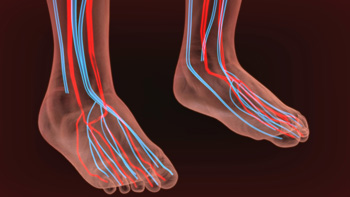 Research has shown there are many people that may experience poor circulation in their feet. Some of the symptoms that may be associated with this ailment may be muscle cramps, feeling a tingling or numbing sensation, or possible sharp pains that may be felt in the feet. A condition that is referred to as peripheral artery disease, also known as PAD, may be a common cause of poor circulation. This typically causes the arteries to become narrow, which may result in nerve damage. Obesity may be an additional reason why poor circulation may occur. The feet must endure additional weight, which may lead to difficulty in exercising, and this may contribute to poor circulation. It’s important to speak with a podiatrist if you feel you are afflicted with poor circulation in the feet.
Research has shown there are many people that may experience poor circulation in their feet. Some of the symptoms that may be associated with this ailment may be muscle cramps, feeling a tingling or numbing sensation, or possible sharp pains that may be felt in the feet. A condition that is referred to as peripheral artery disease, also known as PAD, may be a common cause of poor circulation. This typically causes the arteries to become narrow, which may result in nerve damage. Obesity may be an additional reason why poor circulation may occur. The feet must endure additional weight, which may lead to difficulty in exercising, and this may contribute to poor circulation. It’s important to speak with a podiatrist if you feel you are afflicted with poor circulation in the feet.
While poor circulation itself isn’t a condition; it is a symptom of another underlying health condition you may have. If you have any concerns with poor circulation in your feet contact one of our podiatrists of New Tampa Foot & Ankle. Our doctors will treat your foot and ankle needs.
Poor Circulation in the Feet
Peripheral artery disease (PAD) can potentially lead to poor circulation in the lower extremities. PAD is a condition that causes the blood vessels and arteries to narrow. In a linked condition called atherosclerosis, the arteries stiffen up due to a buildup of plaque in the arteries and blood vessels. These two conditions can cause a decrease in the amount of blood that flows to your extremities, therefore resulting in pain.
Symptoms
Some of the most common symptoms of poor circulation are:
- Numbness
- Tingling
- Throbbing or stinging pain in limbs
- Pain
- Muscle Cramps
Treatment for poor circulation often depends on the underlying condition that causes it. Methods for treatment may include insulin for diabetes, special exercise programs, surgery for varicose veins, or compression socks for swollen legs.
As always, see a podiatrist as he or she will assist in finding a regimen that suits you. A podiatrist can also prescribe you any needed medication.
If you have any questions, please feel free to contact our office located in Wesley Chapel, FL . We offer the newest diagnostic and treatment technologies for all your foot care needs.
The Differences Between a Sprained Toe and a Broken Toe
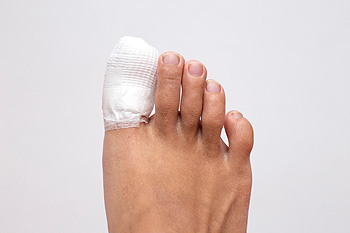 Many people mistake a stubbed toe with a broken toe. This may be a common error because they both produce considerable pain and discomfort. If a toe is broken, it’s important to obtain proper treatment as quickly as possible. If the toe is left untreated, it may affect walking and running ability in addition to experiencing chronic pain. There is known to be a few differences between a broken toe and a sprained toe. These may include bruising, pain in the exact area of the break, or a possible dislocation, which may accompany a fractured toe. A sprained toe may have more generalized pain in the surrounding area where the injury has occurred, although there may be considerable bruising. If you feel you have broken or sprained your toe, it may be beneficial to seek the counsel of a podiatrist to obtain a correct diagnosis and offer the best course of treatment.
Many people mistake a stubbed toe with a broken toe. This may be a common error because they both produce considerable pain and discomfort. If a toe is broken, it’s important to obtain proper treatment as quickly as possible. If the toe is left untreated, it may affect walking and running ability in addition to experiencing chronic pain. There is known to be a few differences between a broken toe and a sprained toe. These may include bruising, pain in the exact area of the break, or a possible dislocation, which may accompany a fractured toe. A sprained toe may have more generalized pain in the surrounding area where the injury has occurred, although there may be considerable bruising. If you feel you have broken or sprained your toe, it may be beneficial to seek the counsel of a podiatrist to obtain a correct diagnosis and offer the best course of treatment.
A broken toe can be very painful and lead to complications if not properly fixed. If you have any concerns about your feet, contact one of our podiatrists from New Tampa Foot & Ankle. Our doctors will treat your foot and ankle needs.
What to Know About a Broken Toe
Although most people try to avoid foot trauma such as banging, stubbing, or dropping heavy objects on their feet, the unfortunate fact is that it is a common occurrence. Given the fact that toes are positioned in front of the feet, they typically sustain the brunt of such trauma. When trauma occurs to a toe, the result can be a painful break (fracture).
Symptoms of a Broken Toe
- Throbbing pain
- Swelling
- Bruising on the skin and toenail
- The inability to move the toe
- Toe appears crooked or disfigured
- Tingling or numbness in the toe
Generally, it is best to stay off of the injured toe with the affected foot elevated.
Severe toe fractures may be treated with a splint, cast, and in some cases, minor surgery. Due to its position and the pressure it endures with daily activity, future complications can occur if the big toe is not properly treated.
If you have any questions please feel free to contact our office located in Wesley Chapel, FL . We offer the newest diagnostic and treatment technologies for all your foot and ankle needs.
